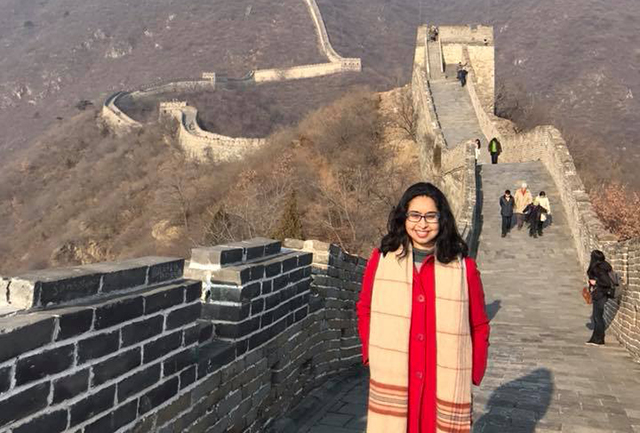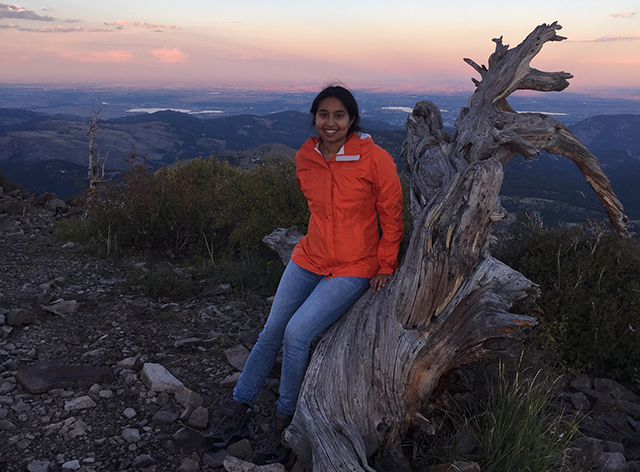Thrill of discovery inspired alumna to pursue research career
Inertial navigation systems helped put a man on the moon.
Using accelerometers and gyroscopes, these computerized systems can calculate position and velocity without the need for external references—which comes in handy out in the vast emptiness of space.
As technical director of an inertial navigation system research program at Draper, an engineering research and development company, alumna Raji Shankar is working on novel applications that continue to push technological boundaries.
“The thing I enjoy the most about this type of development is the ability to work on something new, to do something no one has done before, and to really be the subject matter expert,” said Shankar, who earned a Ph.D. in engineering sciences at the Harvard John A. Paulson School of Engineering and Applied Sciences in 2013.
Shankar was drawn to a scientific career from an early age. Her father worked as an engineering professor, and she was fascinated by how engineers could apply physics and mechanics concepts to make an impact in the physical world.

Shankar, who loves to travel, poses atop the Great Wall of China. (Photo courtesy of Raji Shankar)
As an electrical engineering undergrad at Princeton, Shankar got her first taste of research. She worked on fiber optic systems and conducted experiments on optical metamaterials.
“Unlike doing a problem set, where you are going over a well-thought-out path where someone has already worked out the solution a million times over, with research, you are literally doing something new,” she said. “That’s what appealed to me about a Ph.D.—the opportunity to be the world’s leading expert on a very narrow subject area.”
She joined the lab of Marko Loncar, Tiantsai Lin Professor of Electrical Engineering, where she worked on advanced optical systems. Shankar’s thesis research focused on developing a platform for photonic devices that work at wavelengths in the mid-infrared range.
The mid-infrared range, between three and 12 microns, is particularly interesting to researchers because it corresponds to the absorption lines of many well-known molecular species, such as gases like carbon dioxide, hydrogen sulfide, or nitrous oxide.
These wavelengths of light could be used for spectrographic analysis of a chemical sample, but current trace gas sensing devices are quite bulky, since they incorporate highly reflective mirrors. Shankar spent much of her time in the Center for Nanoscale Systems, where she built tiny chips that could potentially replace the bulky mirrors.
“The potential here is that, by furthering the technology of making devices that store light and generate light at different frequencies using non-linear frequency generation-on-chip, we can perform these techniques at a much smaller scale. For instance, someday we may be able to make a portable breath analysis device,” she said. “That was the deep motivation for my research down the line.”
Although those devices may be years away, Shankar was driven by the practical applications of her work.
Those experiences inspired her to pursue an industry career. Shankar joined Schlumberger-Doll Research, where she worked to develop base sensors for trace gas detection in oil refineries.
“These devices have to work in an incredibly corrosive environment with high pressures or temperatures,” she said. “Designing around those constraints was a constant challenge.”

Shankar pauses at a scenic spot during a hike in Colorado. (Photo courtesy of Raji Shankar)
She moved to Draper in January so she could contribute to a broader range of engineering projects. The opportunity to explore different areas, from robotics, to inertial navigation, to neural implants, keeps the day-to-day work very exciting, she said.
But working as technical director of an inertial navigation research program is not without its challenges. In addition to spending time working on the technical side of the project, Shankar is responsible for ensuring the different elements—optics, electronics, firmware, and machining—all remain in sync. She must juggle those aspects, while keeping a close eye on the budget and schedule.
One of the things she enjoys the most about her work is the chance to stay up-to-date on the latest technologies, and see how those new tools can be used to advance current products and techniques.
“We definitely have to keep abreast of new technology,” she said. “For instance, there is such a boom right now in using machine learning techniques, and applying them to a variety of fields. The landscape has changed so much over just the past two or three years.”
Being at the cusp of new developments, and surrounded by others who are passionate about innovation, inspires Shankar to keep pushing forward. She advises current graduate students to retain the two tools that have helped her the most along the way: an open mind and an inquisitive personality.
